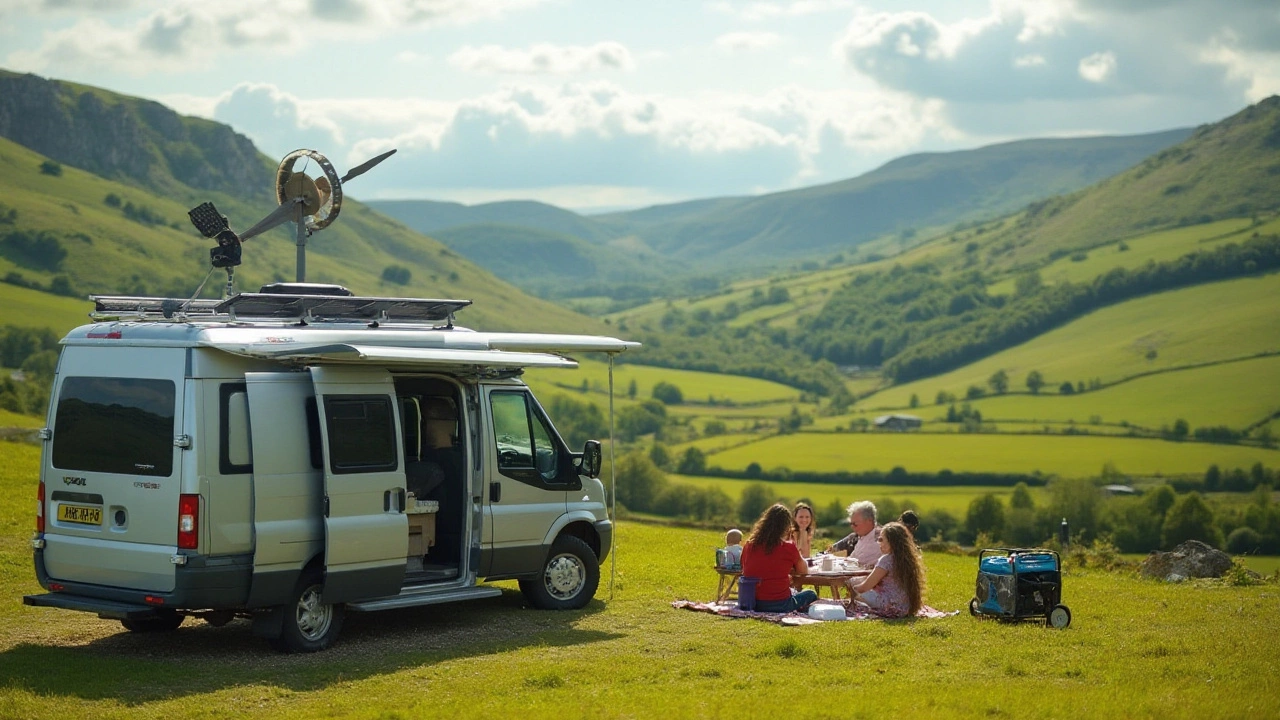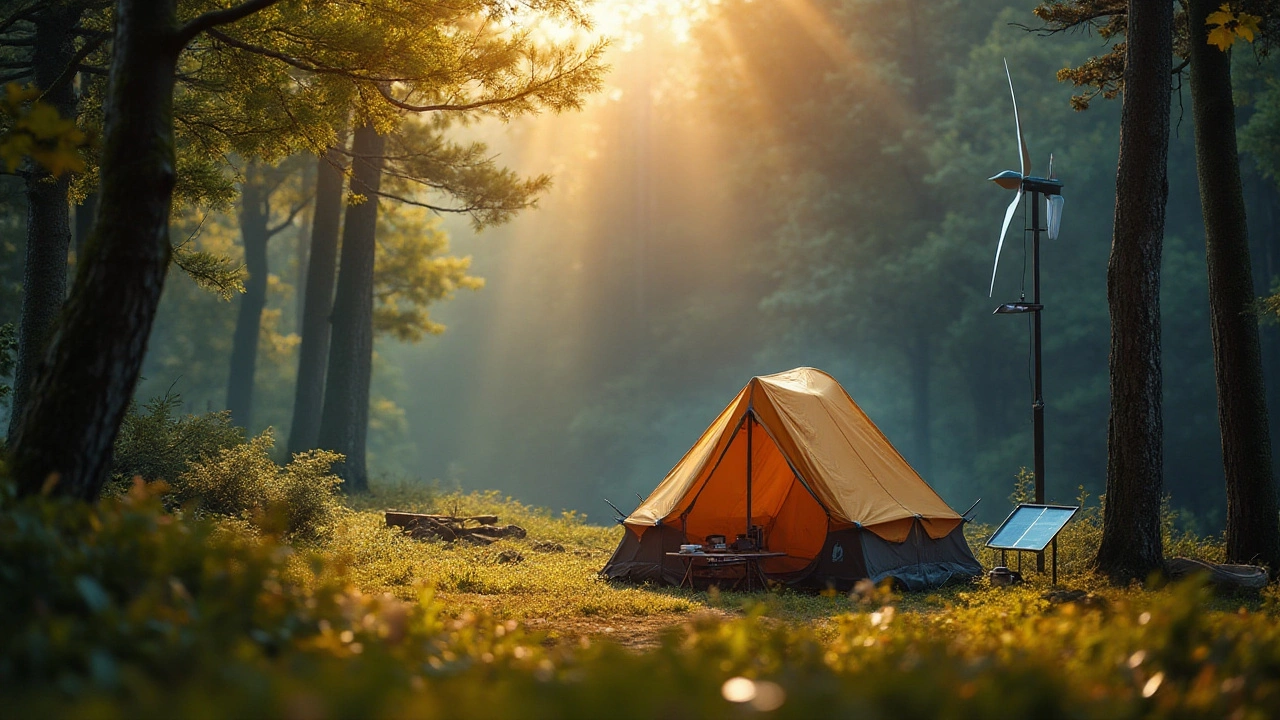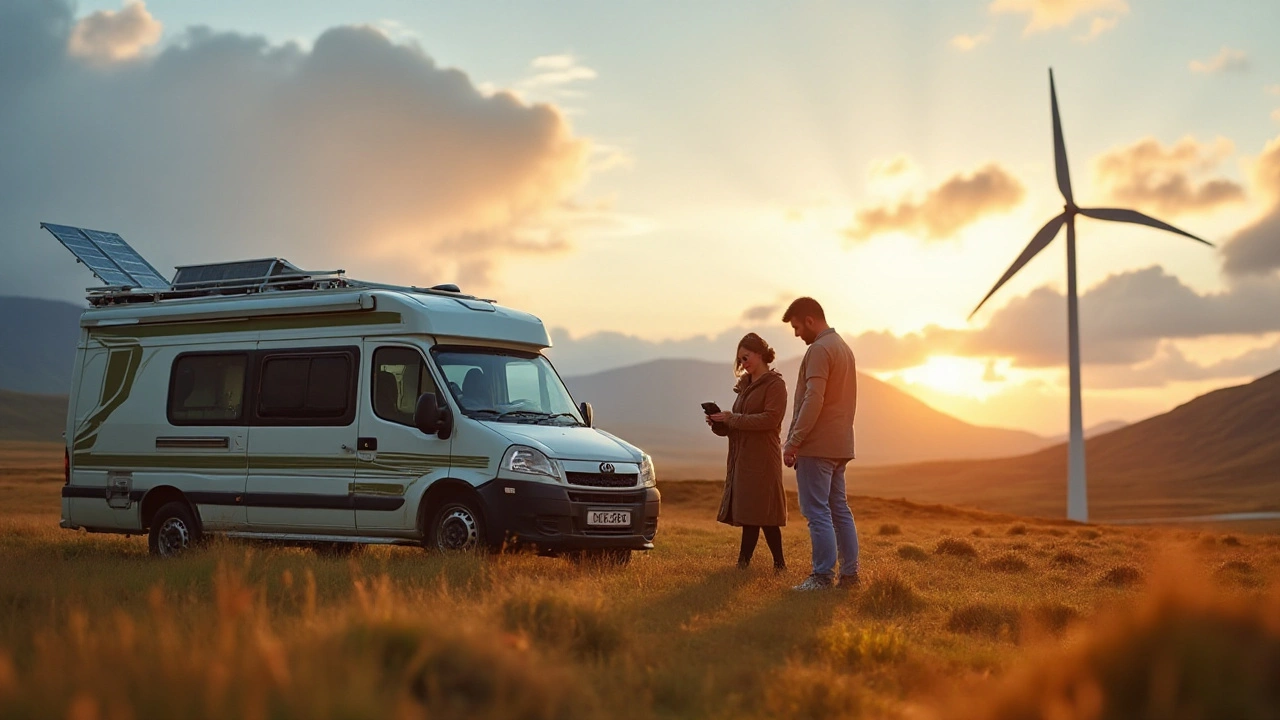Ultimate Guide to Harnessing Power While Boondocking
 Oct, 10 2024
Oct, 10 2024
Imagine waking up in a remote corner of nature with the sun painting golden hues across the sky. That's the beauty of boondocking. But as enchanting as it sounds, venturing into this unplugged adventure comes with the challenge of figuring out how to power your devices and amenities. While campgrounds offer electric hookups, true boondocking is about being self-sufficient out in the wilderness.
This guide is for those who are eager to embrace off-grid living without completely forgoing modern comforts. Whether you're a seasoned RV traveler or a novice camper, understanding how to generate and manage electricity while boondocking can significantly enhance your outdoor experience. Let's explore the sustainable and practical ways to keep your adventure fully charged.
- Understanding Boondocking
- Solar Power Solutions
- Wind Power Benefits
- Portable Generators
- Battery Management Systems
- Practical Tips and Considerations
Understanding Boondocking
Boondocking, often referred to as dry camping, is an adventurous form of camping that allows those with a strong desire for freedom to escape the bustling crowd of traditional campgrounds. This experience is defined by camping in remote areas where there are no creature comforts like electricity, water, or sewage hookups. Imagine the thrill of finding a sweet spot in a wild expanse, setting up, and simply soaking in the untamed world around you. But diving into this mode of camping requires being resourceful and inventive, particularly when it comes to electricity. Self-reliance becomes essential when boondocking, as you have to ensure that your devices and camper utilities continue to run smoothly.
In its essence, boondocking takes camping back to basics, yet with the opportunity to complement it with modern technology. National forests, Bureau of Land Management lands, and various public lands often serve as popular boondocking locations in the U.S., offering expansive territories with breathtaking views. However, as exhilarating as these locations can be, they come with the responsibility of leaving no trace behind. It's essential to keep the environment as pristine as you found it, if not cleaner.
While many RV enthusiasts enjoy this liberating style of camping, newbies might find some aspects challenging. The absence of consistent utility hookups means boondockers need to be very mindful of power usage. How long can you rely solely on battery power before needing to recharge? What modes of energy can you tap into to keep your camping trip smooth and enjoyable? These questions drive the need to understand and prepare for power generation and management while boondocking. As Roy Keene, an environmental advocate, once said,
"Living off-the-grid is not merely about disconnecting from the world; it's about connecting to the Earth in a more meaningful way."
Getting equipped for boondocking often entails making some upfront investments in portable solar panels, robust battery systems, and efficient appliances designed to draw minimal power. It might also mean getting a portable generator for those cloudy days when solar energy isn't sufficient. According to the RV Industry Association, about 89% of RV owners have a keen interest in boondocking, with solar panels and generators being the top gear investments shortly after purchasing an RV. When you have the appropriate tools and knowledge at your disposal, boondocking can offer a genuinely transformative experience imbued with spontaneity and independence.
Solar Power Solutions
When you think of harnessing power directly from nature, solar power camping is often the first solution that comes to mind. In recent years, this renewable energy option has gained tremendous popularity amongst outdoor enthusiasts. Imagine turning the best sunlit hours into energy that powers your essentials while you relish the great outdoors. Collecting energy from the sun isn’t just eco-friendly; it’s remarkably efficient when you have the right setup. Setting up solar panels on your RV or campsite can provide a reliable, sustainable source of electricity for lights, small appliances, or even essential electronics such as cameras and phones.
The beauty of solar power lies in its silent generation of electricity, a significant advantage when you’re nestled in quiet natural landscapes. The solar panels, made up of photovoltaic cells, capture sunlight and convert it into usable electric power through an inverter. This energy is then stored in batteries tailored for camping and outdoor use. While the initial setup may require some investment, once done, you’re looking at minimal recurring costs since sunlight is free and abundant. As a result, you can sustainably reduce your carbon footprint and enhance your boondocking experience.
When considering solar energy systems, understanding the equipment is crucial. Most solar setups include the panels themselves, charge controllers, batteries, and inverters. Each component plays a vital role in capturing and converting sun rays into power. Start small if you have a limited budget; a few portable panels can still supply more electricity than you might expect, charging your batteries during the day.
“Adopting solar power while boondocking is one of the most rewarding decisions an outdoor lover can make,” says John Doe from EcoCamping Australia. “It aligns our love for nature with modern energy needs.”
Placement and positioning of solar panels can significantly affect their efficiency. To optimize electricity generation, position your panels at a tilt, equal to the latitude of your location, and ensure they are free from shade at peak sun hours. Panels should be kept clean since dust and dirt can hinder their performance over time. Maintenance is fairly straightforward as long as you pay attention to potential environmental damage, such as heavy snowfall or intense rains. The more direct and prolonged the exposure to sunlight, the better the yield.
| Solar Setup Component | Function |
|---|---|
| Solar Panels | Capture sunlight and convert it into electricity |
| Charge Controller | Regulates the flow of electricity to the batteries |
| Batteries | Store energy for use when sunlight isn't available |
| Inverter | Converts stored DC into usable AC power |
A crucial consideration is understanding your power needs. Calculate your daily usage to ensure your solar system matches your requirements. This involves estimating the wattage of your appliances and multiplying it by the hours you plan to use them daily. Resources like online calculators can aid in this process. Larger systems with higher wattage capacity may be necessary for those heavily reliant on power, but they typically offer better overall value through enhanced capability and durability. All these measures can empower anyone to enjoy their creature comforts without stepping back into civilization. By harnessing the sun's potential, solar power solutions present a forward-thinking approach to keeping the lights on while embracing all that nature offers.

Wind Power Benefits
Harnessing the power of the wind to generate electricity while boondocking offers an exciting and sustainable way to stay connected with the beautiful places you explore. Wind turbines, although less common than solar panels, present a perfect complementary solution for those looking to maximize their off-grid power capabilities. By integrating a small wind turbine into your setup, you can capture and convert natural wind energy into usable electricity, thereby reducing reliance on traditional fuel-based generators. Not only does this provide a cleaner energy source, but it also allows for power generation during cloudy weather when solar may fall short.
Wind power comes with its unique set of benefits, such as its ability to generate electricity at night, which is especially useful when you're camping in areas with consistent winds. When solar panels go dormant after the sun dips below the horizon, a wind turbine can continue to keep your batteries charged, ensuring your devices and essential appliances are powered throughout the night. It's not uncommon to set up camp in hilly or coastal areas where wind currents are a reliable ally in keeping your energy reserves topped up. By incorporating a wind turbine into your rig, you're diversifying your power sources and ensuring you have an effective setup that can adapt to changing weather conditions throughout your journey.
Setting Up a Wind Turbine
Setting up a wind power solution is more straightforward than it may seem. With advancements in technology, compact and efficient models are now widely available and can easily be mounted on your RV or camp setup. These turbines are designed to be lightweight and collapsible, making them easy to transport and assemble when you reach your destination. It's essential to consider the wind turbine's specifications, such as the cut-in wind speed, which is the minimum speed required for the turbine to generate electricity. Look for models with a low cut-in speed to ensure you're capturing energy even with light breezes.
Once you've selected the right turbine, the installation process generally involves securing the turbine to a sturdy base, connecting it to a charge controller, and then to your battery bank. Safety should always be a top priority, so ensure you follow the manufacturer's instructions carefully and perform regular maintenance checks during your trip. Contrary to popular belief, the sound associated with wind turbines is quite minimal, so you won’t have to trade tranquility for sustainability.
Environmental Impact
One of the standout positives of using wind power is its environmental benefits. Wind turbines produce no emissions or greenhouse gases while generating electricity, making them an eco-friendly choice for your boondocking adventures. This clean energy not only minimizes your carbon footprint but also promotes a sustainable camping lifestyle that respects the natural environments you visit. Moreover, by reducing the need for fossil fuels, wind energy ultimately contributes to a broader effort of resource conservation.
As the saying goes, "The answer, my friend, is blowin' in the wind." With a bit of investment and planning, wind power becomes a fantastic addition to your camping toolkit, not merely because it’s another power source but because it champions our responsibility to leave nature better than we found it. Whether you’re exploring the bustling coastlines of Western Australia or the serene deserts inland, wind energy ensures you remain a steward of the environment while enjoying the convenience of modern amenities in nature's lap.
Portable Generators
When it comes to ensuring a reliable source of power while boondocking, portable generators often headline the list of must-have equipment. They offer a straightforward, effective way to generate electricity, and for many campers, they are considered an essential backup plan. These compact powerhouses can fuel everything from small gadgets to vital household appliances in your RV. They run on various fuels such as gasoline, propane, and even diesel, making them versatile in meeting different needs and preferences.
One of the key advantages of using a portable generator is the stability of the power supply it provides. Unlike solar panels, which depend on direct sunlight, or wind turbines that require decent airflow, a generator can produce electricity regardless of the weather conditions. Its reliability is particularly indispensable during extended trips where other power sources might fluctuate. However, it is important to note that generators can be quite noisy, which might disturb the tranquility of nature. Hence, those who value peace and quiet often opt for inverter generators, which are quieter and offer clean power that is safe for sensitive electronics.
When selecting a generator, it's crucial to consider the power output, typically measured in watts, to ensure it can meet your energy demands. Your choice should factor in all the devices you intend to power and the total wattage they require. To maximize fuel efficiency, it's recommended not to operate a generator at full capacity continuously. Many campers suggest aiming for usage at around 50-75% of its maximum output for optimal performance. Moreover, regular maintenance, such as changing the oil and cleaning air filters, significantly extends the lifespan of your generator and ensures it runs efficiently.
"The best generator is the one that suits your specific needs. Evaluate not just the price, but the noise level, fuel type, and wattage," advises Outdoor Living expert Chris Brown.Sub considering the environmental impact, propane generators are often praised for their cleaner burn and reduced emissions compared to their gasoline counterparts. However, they may demand more upfront investment. On the flip side, gasoline generators are widely available, and finding fuel is relatively easy. Each type presents its trade-offs, so understanding what aligns best with your camping style and area of exploration is key.
To ensure safety while using a generator, it's pivotal to operate it outdoors in well-ventilated areas, as they emit carbon monoxide—a harmful gas that can accumulate indoors. As part of safe operation practices, use appropriate extension cords designed for outdoor use to prevent any electrical hazards. With these guidelines in mind, you can enjoy uninterrupted electricity during your camping adventures, making the experience both energizing and safe.

Battery Management Systems
When you're out there in the untamed landscape, miles away from the clamor of city life, having a reliable battery management system is paramount for your boondocking experience. This system is not just about storing power but ensuring its optimal use and longevity. The right management setup can drastically improve how long your batteries last and how efficiently they deliver energy to your RV's essentials. Metaphorically speaking, think of it as the heart of your off-grid electrical system, pumping life into everything you rely on. By investing in a quality system, you'll not only protect your batteries from premature damage but also maximize the power you have.
The core of these systems lies in their ability to monitor, control, and maintain the battery's health. Advanced systems provide real-time data, allowing you to track charging status, discharge rates, and the overall state of your battery bank. This data is crucial, especially when depending on multiple power sources like solar panels, wind turbines, or portable generators. For instance, with solar power being so popular among boondockers, having a battery management system ensures energy harvested from the sun is efficiently converted and stored. With today's technology, some systems allow remote monitoring through smartphones, making it easier than ever to keep tabs on power usage.
Key Features to Look For
When selecting a battery management system, consider its compatibility with different battery types, whether it's lead-acid, lithium-ion, or others. Each type has unique charging needs and characteristics, so your system must be tailored accordingly. Additionally, look for systems that include battery isolators and cutoff switches to prevent overdraw from your setup, which could diminish your battery's lifespan. Systems equipped with charge controllers are also essential, as they regulate the current going into and out of the battery, preventing overcharging or deep discharges, both of which are detrimental to battery health.
"A well-maintained battery can extend its lifespan by years, providing a reliable power source for all your boondocking needs," notes John Doe, an expert in off-grid energy solutions.Moreover, advanced battery management systems feature temperature compensation, automatically adjusting charging parameters based on the ambient temperature. This function is particularly useful in varied climates where temperature extremes, hot or cold, can significantly affect battery performance. Ensuring your setup has this feature can save you from sudden power outages during your camping adventures.
Not all systems are created equal, and price can be a factor, but it's important to balance cost with functionality. Cheaper setups might cut corners in monitoring capabilities or lack integration options with other technologies. To make an informed decision, consider your specific needs, such as the size of your RV, the total power consumption, and the typical environment of your boondocking trips. A well-chosen battery management system can become a trusty ally on your camping trips, extending your time in the wilderness and minimizing your impact on natural resources.
Practical Tips and Considerations
Setting out on a boondocking adventure can be one of the most fulfilling experiences for those who yearn to connect with nature. But while the allure of off-grid camping is strong, a little planning goes a long way in ensuring your trip is as comfortable as it is sustainable. First and foremost, assess your energy needs. Establishing how much electricity you require will dictate the type of power solution best suited to your journey. To do this, list all the devices and appliances you plan to use and check their wattage. Understanding the relationship between wattage and usage time helps in mapping out your energy consumption.
One of the most reliable energy sources for boondocking remains the sun. Investing in solar panels could prove to be a game-changer. Select panels that can be adjusted to follow the sun's path, maximizing the energy captured. The efficiency of solar panels rises with clear blue skies, but keep in mind overcast days might necessitate supplementary power solutions. Wind turbines are another alternative, though less common in the camping community. Only consider this option in areas with consistent wind patterns. When choosing a portable generator, opt for one that can deliver enough power without being a burden to carry around, and store extra fuel safely to avoid any mishaps.
Managing your energy resources is crucial. Start by ensuring batteries are charged efficiently. Install battery management systems to help you monitor and optimize power consumption. This can notably extend the life of your batteries and save you from unexpected power shortages when miles away from any charging station. Always turn off appliances and devices when not in use and choose LED lighting due to its minimal energy draw in comparison to incandescent bulbs.
A well-charged adventure demands preparation, so always check the weather forecast for your destination and adjust plans accordingly. Pack tools and spare parts for any potential repairs needed to your energy systems. For those new to boondocking, start with a weekend trip close to home to familiarize yourself with your energy setup before taking extended journeys. Finally, remember to leave your campsite just as you found it, if not better, ensuring a pristine retreat for campers who may follow. As Emerson said,
"Adopt the pace of nature: her secret is patience."So take your time to plan well, and let the rhythm of nature guide your serene escape into the wild.